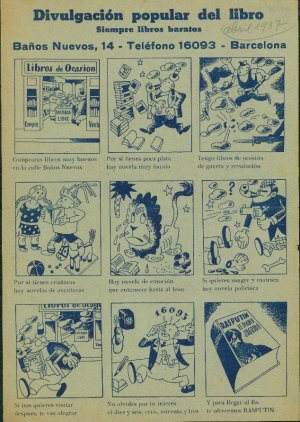
In June and July we’re celebrating the beginning of a new fiscal year by highlighting new acquisitions from the past year. All of these amazing resources will be available for today’s scholars, and for future generations of researchers in the Rubenstein Library! Today’s post features a new collection in the Library’s Hartman Center for Sales, Advertising, and Marketing History. Check out additional posts in the series here.
Since being banned as a tool for gambling in the seventeenth and eighteenth centuries, the auca has become one of the cultural touchstones of the Catalonia region of Spain. Aucas are a kind of comic strip with a standardized format of panels (often 48, or another multiple of four) accompanied by rhyming verse. The Hartman Center recently acquired a collection of more than fifty of these original broadsides, all produced and distributed for the purposes of advertising products or communicating a service. Aucas were traditionally used for communication of religious, literary, or civic information, but advertisers saw the value in taking the broadside format and using it for commercial purposes.

The numerous examples here of aucas published in Barcelona or nearby cities in the Catalan language during the 1940s and 1950s, run counter to the accepted belief that the Franco regime had completely suppressed the Catalan language. As these aucas show, the language still had a public presence (and perhaps the Regime tolerated its use in this particular fashion because the aucas were intended to generate commerce, which Spain desperately needed).


